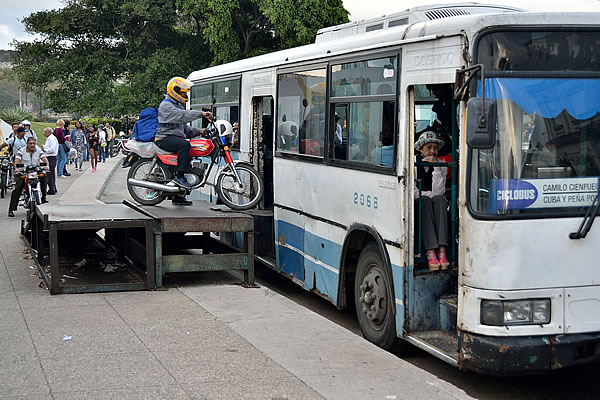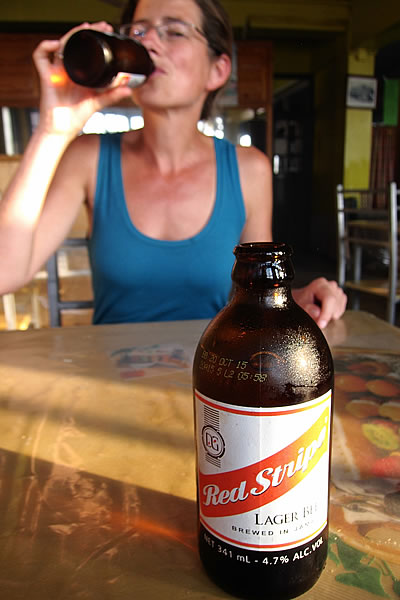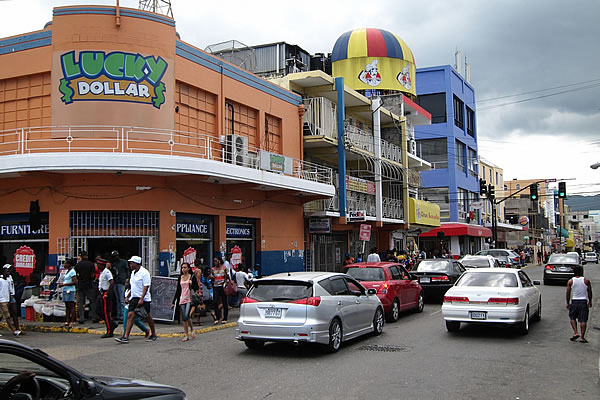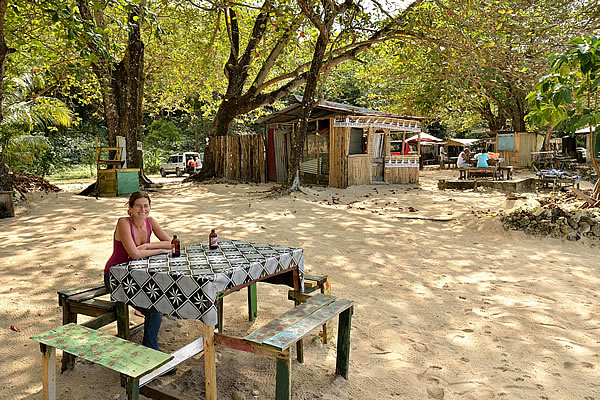

| Reggae, rum and crime | |
Cienfuegos (Cuba) to Long Road (Jamaica), February 2015
|
|
|
|
|
After exactly 30 days, there came an end to our visit to Cuba. Especially the cities of Havana and Matanzas have impressed us. These cities met most of our expectations we had of Cuba; colourful neighbourhoods with old and almost collapsed colonial buildings, and where old smoking American cars provide the transportation for the local people. The other cities in Cuba we visited were also beautiful, but actually it was a kind of repetition of what we have seen in Havana and Matanzas. The landscape was most disappointing. We must admit that we have only visited the western half of the country, and in this part of Cuba the landscape didn’t impress us (with the exception of Zapata). So after a month we were ready to go to the next destination: Jamaica. But before we arrived in Jamaica, we first stayed four days on the Cayman Islands. We booked the flight from Cuba to Jamaica with Cayman Airways, which gave us the opportunity to make a stopover of a few days on Grand Cayman. The small Caribbean island group is best known as a tax haven. Many companies have established their "headquarters" here which they use to skim their taxable profits in other countries. And guess what? The corporate tax rate in the Caymans is 0%. But also many tourists find their way to the Cayman Islands today. They come mainly for sunbathing and as part of a cruise holiday. Additionally, you can see some divers, because the Cayman Islands has some beautiful dive sites (see our article on the Cayman Islands). |
|
 |
|
To cross a tunnel in Havana, motorcycle drivers have to take a bus |
|
On Friday March 13th, we finally flew to Jamaica. Unlike Cuba, Jamaica is a small island and easy to oversee. In a month you can visit the most interesting parts of the island. What we knew in advance about Jamaica was actually not much. Of course we knew the stereotypes like Reggae music, the Jamaican rum and the fact that the country has a bad crime reputation. In Cuba, we met a few Americans who warned us and said that there was a strong possibility that we would be murdered in Jamaica. "That country is totally fucked up" is what he said. Obviously, we didn’t get nervous because we are convinced that it wouldn’t be that bad if you observe some basic rules. The use of common sense and following your intuition takes you a long way is our experience. Our visit to Jamaica began in Montego Bay, a city that we know from the hit Kokomo by the Beach Boys. Many visitors to Jamaica avoid the two major cities of the country, Montego Bay and Kingston, where the crime problems are concentrated. Yet, we still wanted to visit these two places; if only for a few days. Montego Bay has two completely different faces; it is like if the city is schizophrenic. Downtown is grim with a somewhat intimidating atmosphere. Around it are a few poor neighbourhoods which you better avoid if you are not sure which are safe enough and which are not. Outside the centre, it is different. Most travellers stay in one of the hotels on Gloucester Avenue. This is also where the beaches of Montego Bay are. Although this area is largely safe, it still has an annoying amount of 'hustlers', men who want to earn something from travellers. This makes the area not really a relaxing one. That’s why more and more tourists stay in one of the all-inclusive options elsewhere in the Montego Bay area. |
|
 |
|
A typical Jamaican beach in Treasure Beach |
|
|
After our Jamaican introduction in bustling Montego Bay, we crossed to the south coast of the island to experience the tranquillity of the Jamaican beach life. We first stayed a few days in a village called Black River, after which we slightly moved more to the west to a village called Treasure Beach. This is undoubtedly the most relaxing place in Jamaica. Here, nothing happens at all. Although the village is already for decades a destination for foreign individual travellers, all remained the same. There is no large-scale development and the handful of hostels that are there, focus on individual travellers who often stay here for some longer time. This is the Jamaica as we had in mind: a quiet beach with some fishing boats and dilapidated shacks from which Rastafarians sell beer and rum. Ordering is not always easy because the Reggae songs that blare from the ghetto blasters makes communication difficult. Treasure Beach is also a popular destination for middle-aged western women who are looking for some Jamaican love. Where you see mainly older western men looking for young love in Southeast Asia, it is exactly the opposite in Treasure Beach. After Treasure Beach we went to Mandeville. Mandeville is a real Jamaican town without the hassle and bustle of its bigger brothers. We came here mainly for the estate named Marshalls Pen, one of the best places in Jamaica to see the local birds (see our article about bird watching in Jamaica). The town also has a beautiful old vegetable market where all the local fruit and vegetable can be observed and tasted. Via Kingston, we then travelled to Port Antonio, also a nice little town, but this time on the north coast. This is also a great destination for people who want to explore a truly Jamaican town without taking account of the dangers that lurk in the big cities. In addition, Port Antonio is an excellent base for visiting one of the beautiful beaches that lie west of the city. Especially Winnifred beach is special because it is one of the last public beaches of the region. In Jamaica, it is unfortunately the reality that the most beautiful beaches are merged in, in private real estate projects. That means that they won’t be free of charge anymore, or that you can’t visit them anymore at all. We have now arrived at a small village called Long Road. Here is a little 'low key' resort (Zion Country Resort) with simple little rooms (shared bathroom) overlooking the bay of Manchioneal. This is the perfect place to wind down for a while and enjoy the tranquillity. We also use this place as a base for our visit to Ecclesdown Road, one of the other good places to see birds of Jamaica, including two endemic parrots of the country, the Black-billed Parrot and Yellow-billed Parrot. We can get used to this. |
|
 |
|
Ivonne enjoys a local Red Stripe beer on her birthday |
|
 |
|
The busting downtown of Montego Bay |
|
 |
|
This is the type of minibus often used for intercity transport (it can take > 20 passengers) |
|
 |
|
The Marshall Pen estate near Mandeville at dawn |
|
 |
|
Enjoying a beer at Winnifred beach in the Portland parish © copyright - Babakoto.eu / 2015 |
|